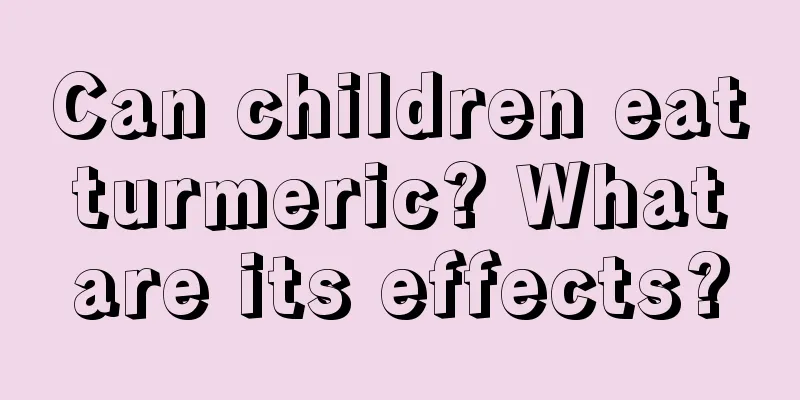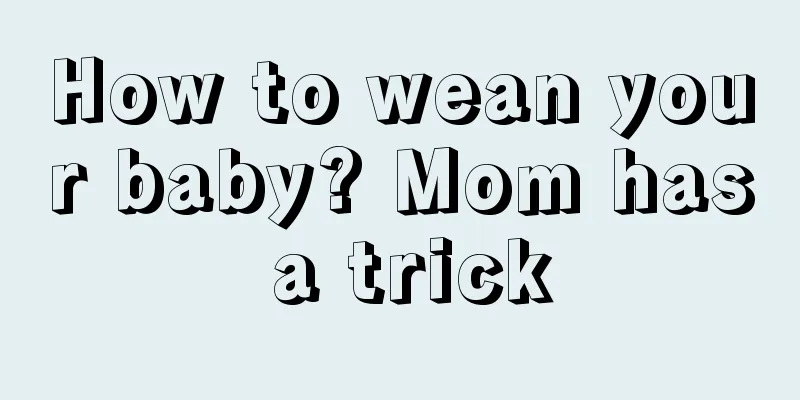What are the methods for removing phlegm from infants and young children? Four methods are recommended

|
Many infants and young children have phlegm in their throats. So, what is going on? What are the methods for infants and young children to eliminate phlegm? Recommendations for expectoration in infants and young children1. Lower respiratory tract infection Phlegm is a secretion of the human respiratory tract. It plays a protective role on the baby's respiratory tract. When the baby inhales dust and harmful particles in the air, they will be adsorbed on the moist bronchial wall. The secretions of the respiratory tract will move from bottom to top through the cilia of the bronchial epithelium, and finally be discharged from the body through the baby's cough, thus playing a role in protecting the lungs. Normal babies have very little sputum. However, when the lower respiratory tract is infected, such as bronchitis or pneumonia, the amount of sputum in the respiratory tract will increase significantly. If it is a bacterial lower respiratory tract infection, the color of the sputum is often yellow or rusty. Viral or mycoplasma, chlamydia infection can also cause damage to the respiratory tract and increase secretions. The solution is as follows: 1. Encourage your baby to cough and expel phlegm. You can also use methods such as patting the back to help your baby expel phlegm. 2. For young babies, if sputum is difficult to cough up and the amount of sputum is large, moisturizing the airway and suctioning the sputum can be used. Keeping the respiratory tract unobstructed is conducive to the recovery of the baby's infection. 3. If it is caused by bacterial infection, effective and thorough anti-infection treatment is the key. 2. Nasal cavity If the baby suffers from allergic rhinitis or sinusitis, the nasal secretions cannot be discharged smoothly and accumulate in the nasopharynx, which can cause coughing and sputum. Parents will feel that the baby has sputum in the throat. The secretions that always stick to the nasopharynx will cause the baby to have difficulty breathing, have an appetite but eat intermittently or cry when feeding, and the inflammation of the nasopharynx can also spread to middle ear inflammation. The solution is as follows: 1. Treat nasal diseases. Flushing out the mucus in the nasal cavity can directly reduce the amount of sputum and keep the nasal cavity unobstructed. 2. Allergic rhinitis: Treat with antihistamines, nasal corticosteroids, and leukotriene receptor antagonists. 3. Sinusitis: Antibiotics such as amoxicillin should be used for treatment. The course of treatment should be at least 2 weeks. Nasal irrigation can help recovery. 3. Digestive tract Gastroesophageal reflux is also a common cause of "phlegm" in babies, which is often manifested by repeated vomiting, coughing and wheezing, and phlegm in the throat. Due to the dysfunction of the lower esophageal sphincter and (or) abnormal tissue structure related to its function, the pressure of the lower esophageal sphincter is low, and the reflux of milk or food occurs, which is easily inhaled into the respiratory tract and causes coughing and wheezing. For such cases, a 24-hour pH test is required to confirm the diagnosis. The solution is as follows: 1. Change your lifestyle: You can change your body position to a semi-recumbent position or prone position leaning forward 30 degrees; eat thick food; eat small meals frequently. 2. H2 receptor antagonist cimetidine and prokinetic drug domperidone can also be used for treatment. 3. Avoid eating chocolate and foods containing coffee. 4. Respiratory allergies There are many inhaled allergens in the world: dust mites, cockroaches, pets, pollen and fungi, etc. The baby's respiratory tract is delicate. After contacting allergens, the body's immune system will release a large amount of inflammatory chemicals, causing capillary dilation, increased permeability of blood vessel walls, and a large amount of secretions in the respiratory tract. At this time, parents will feel that the baby has phlegm or wheezing. It may be accompanied by sneezing, runny nose, nasal congestion, urticaria, etc. The solution is as follows: 1. Control the environment and avoid contact with allergens. Especially on blankets, velvet blankets, and crawling mats that babies come into close contact with, dust and mites are easily accumulated, causing allergies. 2. Pay attention to observation during feeding, add new complementary foods one by one, from small amounts to large amounts, and observe for any signs of allergies. 3. Use necessary anti-allergic drugs such as loratadine. 4. Increase physical exercise to improve respiratory adaptability. Warm reminder: If your baby has respiratory symptoms and does not improve after self-treatment, you need to seek medical attention in time. The above medications must be taken under the guidance of a doctor. Reasons for babies' cough and phlegmThe baby is coughing! The baby has phlegm! Where do the cough and phlegm come from? To be precise, phlegm is something everyone has, and it is a secretion in the respiratory tract. But when foreign germs or other irritants invade, the secretions will increase, and mixed with the residues after the body fights the germs, so the color and amount of phlegm will change, causing discomfort and irritation to the respiratory tract. The main causes of coughing and phlegm are: upper respiratory tract infection, such as rhinitis, sinusitis, pharyngitis; lower respiratory tract infection, such as bronchiolitis, pneumonia. The main symptoms include breathing noise, feeding problems, shortness of breath, large chest fluctuations, and coughing. Expectorant Diet Therapy for Infants and Young Children1. Steamed pear with Sichuan Fritillary Bulbs Ingredients: 1 pear, 5-6 Fritillaria cirrhosa, 2-3 crystal sugars. Method: Wash the pear, cut it horizontally along the handle, dig out the core, add 2-3 crystal sugars and 5-6 Fritillaria cirrhosae, which should be crushed into powder. Align the top of the pear, or use toothpicks to tighten it, put it in a bowl, steam it for about 30 minutes, and give it to your child in two portions. Efficacy: This recipe has the effects of moistening the lungs, relieving cough and resolving phlegm. It is a very popular dietary recipe for treating wind-heat cough. 2. Radish water Ingredients: White radish Method: Wash the white radish, cut it into 4-5 thin slices, put it into a small pot, add half a bowl of water, put it on the fire and bring it to a boil, then simmer for 5 minutes on low heat, turn off the heat, and give it to your child when it is warm. Efficacy: This recipe is very effective for wind-heat cough, dry nose and throat, dry cough with little sputum, especially for babies under 1 year old. Just boiling white radish water and giving it to children to drink can help relieve gas, resolve phlegm, relieve cough, digest food, strengthen the stomach, clear away heat, and promote salivation. It can be drunk 2-3 times a day. How to prevent phlegm in infants' throatsThe following measures are mainly taken for prevention: 1) Increase the time of outdoor activities to 2 hours a day to enhance the ability to resist cold air. 2) Infants under 6 months old should be fed mainly with breast milk and less milk powder and starchy foods. After 4 months, supplementary foods should be added in time to prevent rickets and anemia. 3) Keep the indoor air fresh. |
<<: What are the dangers of diarrhea in children? Four major hazards need to be paid attention to
>>: What are the precautions for babies to eat eggs? 5 precautions to pay attention to
Recommend
How often should baby's nails be trimmed? At what age can baby's nails be trimmed?
When mothers are taking care of their babies, the...
How to tighten a loose belly after childbirth? How to lose weight after childbirth?
During pregnancy, the belly is stretched too much...
What to do if there are lumps in the breast? It is necessary to express milk
It is easy for lumps to appear in the breasts whe...
The water temperature for bathing your baby in winter. What is the best way to keep warm when bathing your baby in winter?
In winter, the indoor temperature is relatively l...
Is it lead poisoning that causes a decline in children's intelligence? Is it lead poisoning that causes a decline in children's intelligence?
Sometimes children suffer from anorexia, poor con...
What is the AMH test? Rapidly test whether the ovaries are suitable for pregnancy
Fertility is a woman's innate ability and rig...
When will the fetus move? What should the frequency of fetal movement be?
Everyone must have heard of fetal movement in lif...
There are white spots on the child's face. Does it mean there are worms in the stomach?
Children usually cannot take care of themselves a...
Is it normal for a newborn baby to fart and have diarrhea after breastfeeding? Is it normal for a newborn baby to have yellow diarrhea after breastfeeding?
For breastfed babies, mothers often observe their...
What are the necessary items for postpartum recovery? Is it necessary to do postpartum recovery?
Pregnancy and childbirth are something that almos...
Is the IVF transfer process painful? What are the symptoms of implantation after a few days of IVF transfer?
With the increasing social pressure, many young c...
What are the side effects of ovulation medication for women?
More and more people are infertile, and many wome...
What are the best names for boys born in the Year of the Rat? List of names for boys born in the Year of the Rat in 2020
In one month, the 2020 Rat baby will be born. For...
What is induction labor? What is suction labor?
Childbirth refers to the process of giving birth ...
Can a four-month-old baby drink juice? Can a four-month-old baby drink juice?
When the baby is four months old, you can try to ...









